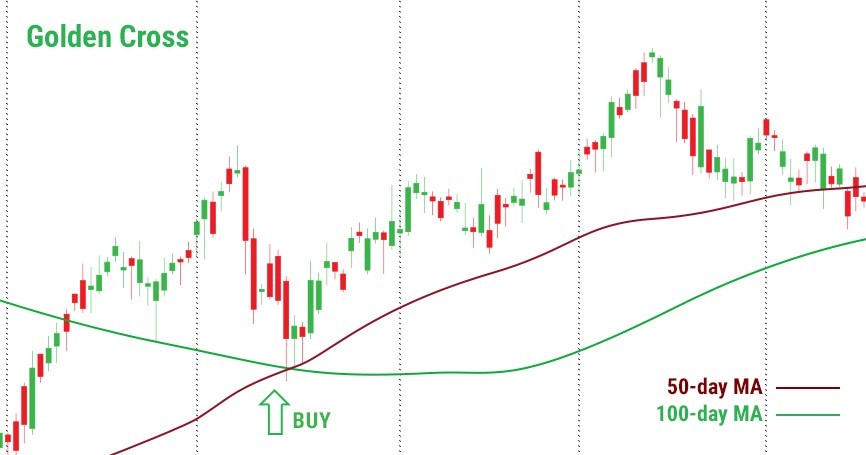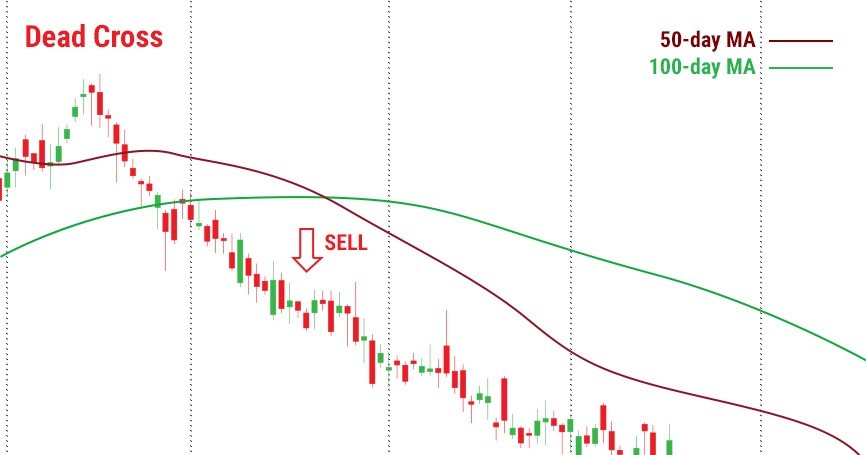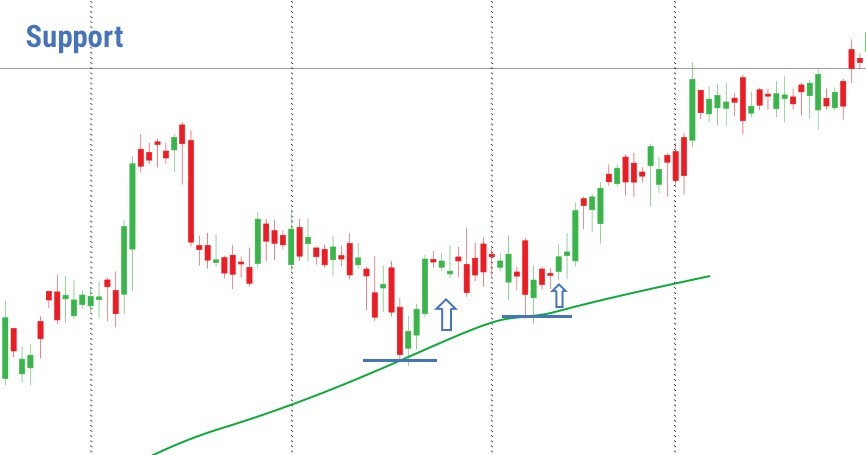Moyenne mobile : un moyen simple de trouver une tendance
Les informations données ne sont pas des conseils en investissement
La moyenne mobile est l'un des indicateurs les plus utilisés dans le trading. Les traders l'adorent pour sa simplicité et son efficacité.
Dans cet article, nous vous expliquerons en quoi consiste cet indicateur ainsi que comment l'utiliser pour augmenter vos bénéfices.
La moyenne mobile est un indicateur de tendance. Cet indicateur utilise les données de prix moyens et, ensuite, il analyse l'actions des prix à partir des fluctuations.
Types d'indicateur de MM
Il existe 4 types principaux de moyenne mobile que vous pouvez implémenter dans MetaTrader. Ici, nous ne vous donnerons pas de formules compliquées. Il est plus important que vous compreniez l’idée de chaque type.
- Moyenne mobile simple
Habituellement, les traders utilisent la moyenne mobile simple. Ce type de MM indique la moyenne des prix de clôture pour la période considérée. En conséquence, tous les prix sont égaux en valeur. Par exemple, si nous avons une MM sur 10 jours, nous calculons une somme de 10 prix de clôture et nous la divisons en 10. Chaque fois qu'une nouvelle clôture de prix se forme, la plus ancienne n'est plus comptée.
- MM exponentielle et la MM pondérée linéaire
La MM exponentielle et la MM pondérée linéaire sont assez similaires. Elles calculent les derniers prix avec le coefficient le plus élevé. En conséquence, ces MM reflètent les mouvements des prix et donnent des signaux plus rapidement. Faites attention ! Ces MM génèrent des signaux rapides, mais certains peuvent être faux.
- MM lissée
La MM lissée est basé sur la MM simple. Il est facile de définir sa fonction principale grâce à son appellation. Cette MM lisse le mouvements des prix à partir des plus grandes fluctuations. Cette MM est la meilleure pour définir une tendance.
Comment la mettre en place
La MM est présente dans MetaTrader, vous n’avez donc pas besoin de la télécharger. Allez dans "insert" et trouvez "indicators" puis "trend" et vous verrez la moyenne mobile. Il est très important d’appliquer les paramètres corrects.
Période
Une période est le nombre de chandeliers qui seront pris en compte pour le calcul. Plus la période est grande, plus la MM est lisse et les signaux plus précis. Plus la période est courte, plus la MM sera proche du prix.Il n'y a pas de règle unique sur la période de MM à utiliser. En analysant les graphiques avec des intervalles de temps importants, les traders préfèrent les MM avec des périodes telles que 50, 100 et 200. Pour trader sur des intervalles de temps plus courts, les investisseurs préfèrent les périodes plus courtes, telles que 9, 12 et 26.
Prix
Il y a plusieurs options. Il peut s'agir de prix de clôture, d'ouverture, hauts, bas, médians, typiques et pondérés. Cependant, les traders utilisent généralement le prix de clôture.
Décalage
Ce paramètre est utilisé pour tirer l'indicateur d'avant en arrière en matière de temps. En conséquence, la MM va monter ou descendre.
Comment utiliser les moyennes mobiles dans le trading Forex
Une chose que nous devons vous dire. Les MM donnent des signaux retardés car elles calculent le dernier cours de clôture. Prenez ceci en compte lorsque vous les utilisez pour trader.
- La MM étant un indicateur de tendance, nous commencerons par une détection de tendance. Si vous voulez savoir si le marché est baissier ou haussier, une croix vous aidera.
Croix dorée
Quand une MM avec une période plus courte croise une MM avec une période plus longue vers le haut, c’est un signal d’achat.

Croix de la mort
Quand une MM avec une période plus courte croise une MM avec une période plus longue vers le bas, c’est un signal de vente.

- Plus sur la fonction de tendance. Si l'indicateur baisse, c'est une tendance à la baisse. Si la MM monte, c'est une tendance à la hausse.
- La moyenne mobile est très utilisée comme niveau de soutien et de résistance. La force des niveaux dépend de la période de la MM. Plus la période est longue, plus le soutien/la résistance est fort(e). L'intervalle de temps joue également un rôle important. Plus le délai est important, plus les MM seront fortes. Si vous comparez la MM de 200 heures à la MM de 200 jours, la dernière sera un niveau plus fort et, par conséquent, le prix fluctuera probablement autour de celle-ci.
En utilisant les MM comme niveaux de soutien et de résistance, nous avons la possibilité de déterminer les niveaux afin d'ouvrir une position. Lorsque le prix dépasse la MM, cela peut être un signal d'achat. Inversement, un dépassement en dessous de la MM donnera un signal de vente. Astuce : si le prix touche plusieurs fois la MM, cela signifie qu’un renversement est proche.

MM et autres indicateurs
Un grand avantage des MM, c'est que ce ne sont pas des indicateurs solitaires ; elles font partie d'autres indicateurs techniques. Le plus célèbre indicateur qui se base sur les MM est la MACD. Vous pouvez également trouver des MM avec des outils de trading tels que Alligator, les bandes de Bollinger, Ichimoku Kinko Hyo.
Nous rappelons toujours aux traders qu’il n’existe pas d’indicateur parfait, c’est pourquoi il est important de les combiner afin d'obtenir des signaux plus forts.
Quels indicateurs sont les meilleurs pour une combinaison avec des MM ?
C’est toujours une bonne idée d’utiliser des chandeliers avec les MM. Ils donnent des signaux forts sur un retournement et sur une poursuite de la tendance. Les autres indicateurs pouvant être utilisés avec les MM sont les oscillateurs .
N'oubliez pas que vous avez besoin d'identifier au moins de 2 signaux correspondant afin de pouvoir commencer à trader.
En bref : La moyenne mobile est l'indicateur technique de tendance qui reflète les mouvements de prix. Elle donne des signaux retardés, mais elle est toujours très utile car ses signaux sont forts. Achetez lorsque le prix est supérieur à la MM et lorsque vous voyez une croix dorée. Vendez lorsque le prix est inférieur à la MM et que vous voyez une croix de la mort.
Autres articles de cette section
- Intervalles de temps
- Graphique en Renko
- Types de graphiques
- Heiken Ashi
- Politique d'assouplissement quantitatif
- Points Pivots
- Williams’ Percent Range (%R)
- RVI (Relative Volatility Index)
- Momentum
- Indice de force
- Enveloppes
- La Puissance des Haussiers (Bulls Power) et la Puissance des Baissiers (Bears Power)
- Comment trader en se basant sur les décisions des banques centrales ?
- CCI
- Parabolique SAR
- Stochastique
- RSI (Indice de force relative)
- Oscillateurs
- ADX
- Bandes de Bollinger
- Indicateurs de tendance
- Introduction aux indicateurs techniques
- Support et résistance
- Tendance
- Analyse technique
- Banques centrales : politique et effets
- Facteurs fondamentaux
- Analyse fondamentale
- Analyse technique vs analyse fondamentale











